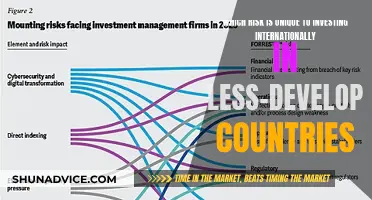
Debt instruments are a vital component of a well-rounded investment portfolio. They are characterised by the safety of the principal amount and a fixed, regular income. In India, debt investment options are often synonymous with fixed deposits, but there are several other options to consider. This includes corporate fixed deposits, non-convertible debentures, debt mutual funds, and market-linked debentures. Each option has its own set of risks and returns, and investors should carefully evaluate these before making any decisions.
| Characteristics | Values |
|---|---|
| Definition | A debt instrument is an asset that individuals, companies, and governments use to raise capital or to generate investment income |
| Types | Corporate fixed deposits, non-convertible debentures, debt mutual funds, market-linked debentures, senior secured bonds, fixed deposits, government bonds, Sukanya Samriddhi Yojana, public provident fund, treasury bills, certificate of deposit, credit facilities, fixed-income debt instruments, fixed-income trading |
| Risk | Debt instruments are considered less risky than equity investments |
| Returns | Debt instruments offer lower returns than equity investments |
| Taxation | Debt Mutual Funds held for up to three years are taxed as short-term capital gains (STCG) and added to the taxable income. Held for more than three years, they are taxed as long-term capital gains (LTCG) at 20% with indexation benefits |
What You'll Learn

Corporate fixed deposits
Benefits of Corporate Fixed Deposits
One of the main advantages of corporate fixed deposits is the potential for higher interest rates compared to bank fixed deposits. This difference in interest rates, typically ranging from 1% to 3%, can have a significant impact on the investor's corpus over time. Corporate fixed deposits also tend to have lower lock-in periods and more flexibility in terms of interest payment options. Investors can choose from monthly, quarterly, half-yearly, or yearly interest payouts or opt for a cumulative option where the interest is reinvested, allowing for the benefit of compounding.
Risks and Considerations
While corporate fixed deposits offer higher returns, they also carry more risk than bank fixed deposits. In India, bank deposits up to ₹5 lakhs are insured by the Deposit Insurance and Credit Guarantee Corporation (DICGC), an RBI subsidiary. However, corporate fixed deposits do not have this insurance cover, so investors bear the risk of default by the company. Therefore, it is crucial to assess the creditworthiness of the company before investing. Reputable credit rating agencies such as CRISIL, ICRA, and CARE assign ratings to corporate fixed deposits, indicating the level of risk associated with them. It is advisable to invest in highly-rated corporate fixed deposits, preferably with an AAA rating, to minimise the risk of default.
Eligibility and Documentation
Tax Implications
Interest earned on corporate fixed deposits is taxable according to the investor's income tax bracket. If the interest income exceeds ₹5,000 in a financial year, TDS will be deducted. Investors can avoid TDS by submitting Form 15G (or Form 15H for senior citizens) to the financial institution.
Choosing the Right Corporate Fixed Deposit
When selecting a corporate fixed deposit, it is essential to consider the credit rating, interest rate, financial history, and repayment history of the company. Opting for a highly-rated corporate fixed deposit from a reputable company with a good track record of timely repayments can help minimise risk and ensure stable returns.
Generation Investment Management: A Guide to Getting Started
You may want to see also

Non-convertible debentures (NCDs)
NCDs are issued by corporates to raise funds from the public and offer a fixed return. This is done through a public issue and subsequently traded either over the counter (OTC) or on exchanges. NCDs offer various benefits to the owner, such as high liquidity through stock market listing, tax exemptions at source, and safety. This is because they can only be issued by companies with a good credit rating, as specified by the RBI.
NCDs are easily tradable and are listed on open stock markets and exchanges. The interest on NCD investments is paid by direct bank credit, and they are digitised and issued in the demat form only. NCDs are also lower risk, as only companies with a good credit rating can issue secured NCDs.
Secured NCDs are considered safer than unsecured NCDs as they are backed by the assets of the company. In the event of the issuing company failing to pay on time, investors can recover their dues by liquidating the company's assets. However, the interest offered on secured NCDs is lower than that of unsecured NCDs.
When investing in NCDs, it is important to consider the credit rating of the issuer, the interest rates, and the risks related to the issuing company. Investors should choose a company with an AA rating or above and perform background checks on the asset quality of the company. It is also advised not to invest if the company allocates more than 50% of its total assets towards unsecured loans.
Crafting a Compelling Investment Narrative: Guide to Portfolio Storytelling
You may want to see also

Debt mutual funds
Debt funds are considered a good investment option for those looking to preserve their capital and earn better post-tax returns than fixed deposits (FDs). They are also suitable for investors who want to invest in the safer side of mutual funds, such as risk-averse investors, retired persons, and conservative or first-time mutual fund investors.
Debt funds can be considered for an investment horizon of one day to up to three years. They offer better post-tax returns compared to FDs if the investor stays invested for at least three years. Liquid debt funds are a great option for parking emergency funds, as they provide better returns than savings bank accounts without taking on too much risk.
There are various types of debt funds available in India, including:
- Money market funds: These funds invest in short-term debt instruments such as treasury bills and commercial paper, offering high liquidity and minimal risk.
- Short-duration debt funds: These funds focus on debt instruments with maturities of up to three years, providing a balance between stability and the potential for higher returns compared to money market funds.
- Long-duration debt funds: These funds invest in debt instruments with maturities exceeding three years, offering higher potential returns but also exposing investors to increased interest rate risk.
- Gilt funds: These funds primarily invest in government bonds, offering a high level of safety and predictable returns.
- Corporate bond funds: These funds invest in bonds issued by corporations, providing the potential for higher returns but carrying higher credit risk.
When investing in debt funds, it is important to consider factors such as taxes, investment tenure, liquidity needs, and the credit quality rating of the underlying debt instruments. While debt funds are considered relatively safe, they are not risk-free and are exposed to interest rate risk and credit risk.
National Savings and Investments: A Secure Financial Future
You may want to see also

Market-linked debentures (MLDs)
In principal-protected MLDs, the investor's principal is safe from the performance of the external benchmark, whereas, in non-principal-protected MLDs, even the principal is at risk if the external benchmark's value is not in favour of the investor. MLDs are generally issued for a tenure ranging from 12 to 60 months.
The minimum investment in MLDs was reduced to Rs. 1 lakh from Rs. 10 lakhs, effective January 1, 2023. MLDs are typically zero-coupon bonds, meaning they don't have interest payments associated with them. The payoff or gain from these instruments is linked to a market index, such as NIFTY 50 or the government bond yield.
The biggest advantage of investing in MLDs is the better tax treatment they receive compared to other types of bonds and debentures. MLDs are also a good option for investors seeking higher returns and willing to take on higher risks. However, it is important to note that MLDs are not risk-free and are subject to market risk and other common risks associated with bonds, such as credit default risk, reinvestment risk, interest rate risk, and liquidity risk.
When considering investing in MLDs, it is essential to understand the complexities and risks involved. Retail investors with limited knowledge of bonds should seek financial advice before investing in MLDs.
Protect Your Investment Portfolio: Strategies for Success
You may want to see also

Senior secured bonds
In India, senior secured bonds are issued by big corporations and Non-Banking Financial Companies (NBFCs) to source funds from the market. They are a safer option for investors who want to diversify their portfolio but minimise risk. The bonds are also rated by credit rating agencies, making it easier for investors to choose.
However, senior secured bonds are not easily transferable or redeemable, meaning they have low liquidity. There is also always a credit risk involved with the bonds. If the issuer fails to maintain the quality of the loan, there is a chance of default on timely payments.
Investing vs Saving: Understanding the Key Differences
You may want to see also
Frequently asked questions
Debt instruments include corporate fixed deposits, non-convertible debentures (NCDs), debt mutual funds, and market-linked debentures (MLDs).
Debt instruments are a way for individuals, companies, and governments to raise capital or generate investment income. Investors provide a lump sum in exchange for interest payments at regular intervals.
Debt instruments carry three types of risks: credit risk, interest rate risk, and liquidity risk. Credit risk refers to the possibility of the issuer defaulting on repayment of the principal and interest. Interest rate risk refers to the impact of changing interest rates on the value of the investment. Liquidity risk is the risk that the fund house will not have enough liquidity to meet redemption requests.
When selecting a debt instrument, consider factors such as the duration or time horizon of the investment, the AUM (total investment) of the scheme, and the expense ratios involved. It's also important to assess your risk tolerance and financial goals before making a decision.







